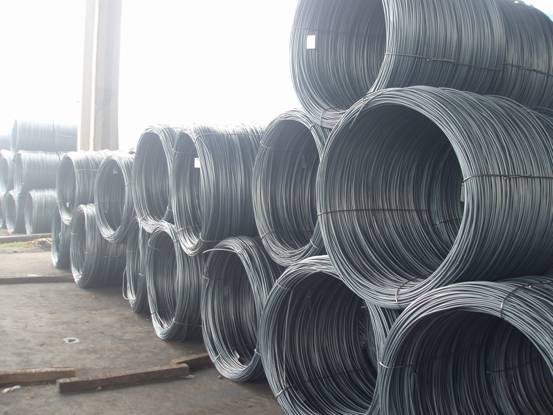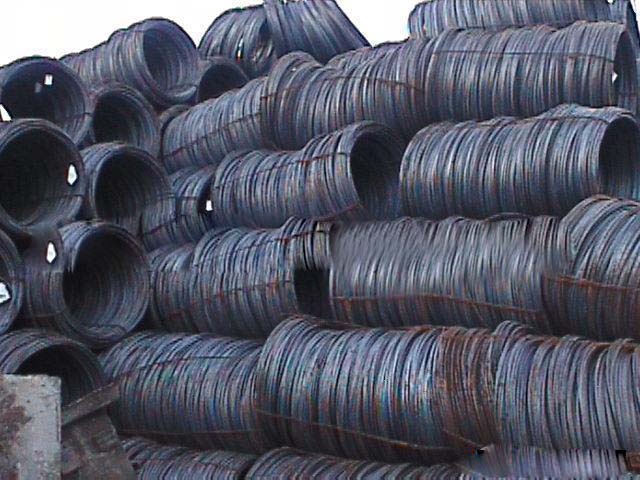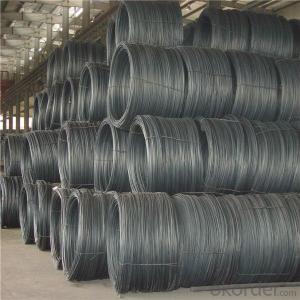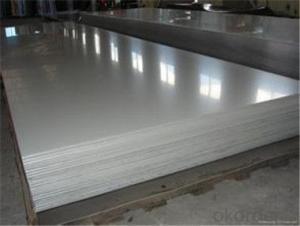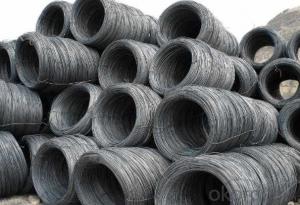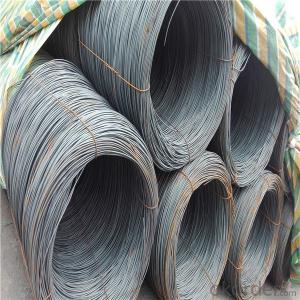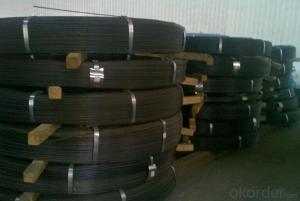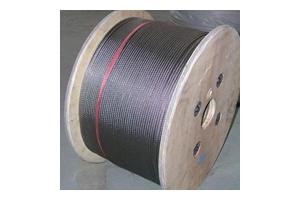alloyed wire rod
- Loading Port:
- China Main Port
- Payment Terms:
- TT OR LC
- Min Order Qty:
- -
- Supply Capability:
- -
OKorder Service Pledge
OKorder Financial Service
You Might Also Like
Wire Rod Q235 Details:
| Minimum Order Quantity: | 25 Tons | Unit: | m.t. | Loading Port: | XINGANG PORT,China |
| Supply Ability: | 100,000 Tons Per Month | Payment Terms: | TT or LC |
Product Description:
Specifications of Wire Rod Q235:
Steel Grade: Q235, Standard: GB Diameter: 5.5mm, 6.5mm, 7mm,8mm,9mm,10mm,12mm,14mm
Diameter Tolerance:±0.3mm 6.5mm can be drawing into 2mm/8.0mm can be drawing into 3mm
Brand Name: N-RIVER Place of Origin: Hebei, China Mainland Application: construction, building etc
Chemical Composition:
Please kindly find our chemistry of our material based on Q235 as below for your information
Trademark | Rank | Chemical composition (quality score) % | |||||
C | Si | Mn | S | P | |||
| ≤ |
| ≤ | ≤ | |||
Q235 | A | 0.14-0.22 | 0.30 | 0.30-0.65 | 0.050 | 0.045 | |
Q235 | B | 0.12-0.20 | 0.30 | 0.30-0.70 | 0.045 | 0.045 | |
Trademark | Rank | Pulling Test | |||||
Bend PointΔs/Mpa | Tensile Strength | Elongation Ratioδ5% | |||||
Thickness (Diameter) /MM | Thickness (Diameter) /MM | ||||||
≤16 | 16-40 | ≤16 | 16-40 | ||||
≥ | ≥ | ||||||
Q235 | A | 235 | 225 | 375-500 | 26 | 25 | |
Q235 | B | 235 | 225 | 375-500 | 26 | 25 | |
Usage and Applications of Wire Rod Q235:
After hot-rolled the products shaped into coil and delivery as finished product, including round, square, rectangular, hexagonal and so on. Since most of the products are round, it is generally called wire rod. Carbon steel wire rod is widely used in construction and manufacturing. Carbon steel wire rod is mainly used for reinforcement of reinforced concrete and welded structure or reprocessed (roberts , nail, etc.) materials, especially used to produce wire drawing, welding electrode, nails, spring, electronic, precise machinery parts and so on.
Packaging & Delivery of Wire Rod Q235:
Packaging Detail: products are packed in coil and then shipped by container or bulk vessel
Each coil weight: 2-3MT
Delivery Detail: within 45 days after received deposit or LC.
Label: to be specified by customer, generally, each bundle has 1-2 labels
Trade terms: FOB, CFR, CIF
- Q: What are the major steel wire rod consuming industries?
- The major steel wire rod consuming industries include construction, automotive, machinery, and electrical appliances.
- Q: How is steel wire rod recycled in a steel production facility?
- Several steps are involved in the recycling process of steel wire rods to ensure efficient and sustainable reuse of this material in a steel production facility. Here is a breakdown of how the recycling process of steel wire rods takes place: 1. Collection and Sorting: Steel wire rods are collected from various sources, such as scrap yards, demolition sites, or manufacturing plants, and sorted based on their quality and composition. This sorting process allows for better control over the recycling process and ensures that only suitable materials are used. 2. Shredding and Fragmentation: Once sorted, the steel wire rods are shredded using heavy-duty machines, breaking them down into smaller pieces. This fragmentation increases the surface area of the material, making it easier to handle in subsequent steps. 3. Magnetic Separation: After shredding, powerful magnets are used to extract any ferrous materials, such as iron and steel, from the fragmented steel wire rods. This process effectively removes impurities and contaminants, leaving behind clean steel wire rods. 4. Melting and Purification: The clean steel wire rods are melted in a furnace at extremely high temperatures, turning the solid fragments into molten steel. Various additives and chemicals can be introduced during the melting process to refine the steel's composition and properties. 5. Casting and Solidification: The molten steel is then cast into molds to form new steel products or billets. These molds can be customized based on the desired shape and size of the final product. The molten steel is poured into the molds and left to cool and solidify. 6. Rolling and Drawing: After solidification, the steel billets go through rolling mills that progressively reduce their size and shape them into the desired final product, such as wire rods, bars, or sheets. If necessary, the steel may also undergo a drawing process, where it is pulled through a series of dies to achieve the desired diameter and shape. 7. Quality Control and Finishing: Before the final product is ready, it undergoes rigorous quality control inspections to ensure it meets the required specifications and standards. Any defects or imperfections are identified and corrected. Once approved, the steel wire rods are typically cleaned, coated, or treated to enhance their durability, corrosion resistance, or other desired properties. In summary, the recycling process of steel wire rods in a steel production facility involves collection, sorting, shredding, magnetic separation, melting, casting, rolling, quality control, and finishing. This comprehensive process effectively recycles steel wire rods, reducing the need for virgin materials and promoting sustainability within the steel industry.
- Q: What are the common production processes for fermium-coated steel wire rod?
- The common production processes for fermium-coated steel wire rod typically involve a series of steps. First, the steel wire rod undergoes surface preparation, including cleaning and removal of any impurities. Then, it is immersed in a solution containing fermium, ensuring a uniform coating on the surface. After coating, the wire rod is subjected to a drying process to remove any excess solution. Finally, it may undergo further treatments such as heat treatment or mechanical processes to enhance its properties before being ready for use.
- Q: What are the advantages of using steel wire rod in mechanical components?
- There are several advantages of using steel wire rod in mechanical components. Firstly, steel wire rod offers high strength and durability, making it capable of withstanding heavy loads and providing excellent structural support. Secondly, steel wire rod has good flexibility and elasticity, allowing for easy bending and shaping, which is crucial in designing complex mechanical components. Additionally, steel wire rod is highly resistant to corrosion, ensuring the longevity and reliability of the components even in harsh environments. Furthermore, steel wire rod is readily available and cost-effective, making it a preferred choice for various industrial applications. Overall, the use of steel wire rod in mechanical components enhances their performance, longevity, and cost-efficiency.
- Q: What are the different surface finishing materials used for steel wire rod?
- There are several surface finishing materials used for steel wire rod, each offering unique properties and benefits. Some of the commonly used surface finishing materials for steel wire rod include: 1. Zinc Coating: Zinc coating, also known as galvanizing, is one of the most common surface finishing materials used for steel wire rod. It involves applying a layer of zinc to the surface of the wire rod through a hot-dip or electroplating process. Zinc coating provides excellent corrosion resistance and acts as a sacrificial anode, protecting the underlying steel from rust and corrosion. 2. Phosphate Coating: Phosphate coating is another widely used surface finishing material for steel wire rod. It involves treating the wire rod with a phosphate solution, which creates a thin layer of phosphate crystals on the surface. Phosphate coating improves the adhesion of subsequent coatings, such as paint or powder coating, and provides enhanced corrosion resistance. 3. Epoxy Coating: Epoxy coating is a thermosetting polymer that is applied as a protective layer on the surface of steel wire rod. It provides excellent resistance against chemicals, abrasion, and corrosion. Epoxy coating also improves the wire rod's durability and extends its service life. 4. Powder Coating: Powder coating is a popular surface finishing method that involves electrostatically applying a dry powder to the steel wire rod's surface. The powder is then cured under heat, forming a hard and durable coating. Powder coating offers a wide range of colors and finishes, improved resistance to chipping and scratching, and enhanced corrosion protection. 5. Chrome Plating: Chrome plating is a surface finishing process that involves depositing a layer of chromium onto the steel wire rod's surface. Chrome plating provides excellent corrosion resistance, wear resistance, and a decorative finish. It is commonly used in applications where aesthetics, durability, and corrosion protection are crucial. 6. Nickel Plating: Nickel plating is another surface finishing material used for steel wire rod. It involves depositing a layer of nickel onto the wire rod's surface, providing enhanced corrosion resistance and a bright finish. Nickel plating also improves the wire rod's solderability and facilitates better electrical conductivity. These are just a few examples of the different surface finishing materials used for steel wire rod. The choice of coating or plating depends on the specific requirements of the application, such as corrosion resistance, aesthetics, and functional properties.
- Q: What are the different surface treatment processes used for steel wire rod?
- There are several different surface treatment processes used for steel wire rod, each designed to enhance its corrosion resistance, improve its aesthetic appearance, or provide specific functional properties. One common surface treatment process is galvanizing, where the steel wire rod is coated with a layer of zinc. This process helps protect the steel from corrosion, as the zinc acts as a sacrificial anode, corroding instead of the steel. Galvanizing can be done through hot-dip galvanizing or electroplating, depending on the specific requirements. Another surface treatment process is phosphating, which involves applying a layer of phosphate coating to the steel wire rod. This process improves the adhesion of subsequent coatings or paints, enhances corrosion resistance, and provides increased wear resistance. Electroplating is a process that involves depositing a layer of metal onto the surface of the steel wire rod using an electrolytic cell. This can be done with various metals, such as zinc, nickel, or chromium, to provide corrosion resistance, improve aesthetics, or enhance specific properties like hardness or conductivity. Furthermore, heat treatment processes, such as annealing or quenching and tempering, can be used to modify the microstructure of the steel wire rod's surface. These processes can improve the wire's mechanical properties, such as strength, ductility, and toughness. Additionally, surface coating processes like powder coating or paint application can be used for steel wire rod to provide aesthetic appeal, protect against corrosion, or improve friction characteristics. Overall, the choice of surface treatment process for steel wire rod depends on the desired outcome and the specific application requirements. Whether it is for corrosion resistance, improved aesthetics, enhanced mechanical properties, or functional purposes, these treatment processes play a crucial role in ensuring the performance and longevity of steel wire rod in various industries.
- Q: What are the major steel wire rod producing countries?
- The major steel wire rod producing countries include China, Japan, India, and the United States.
- Q: What are the different sizes and diameters available for steel wire rod?
- The sizes and diameters available for steel wire rod vary depending on the specific requirements and applications. Common sizes range from 5.5mm to 20mm in diameter, with some manufacturers offering larger sizes up to 32mm. The lengths typically range from 2,000mm to 6,000mm, but custom lengths can also be produced. It is important to note that each manufacturer may have its own range of sizes and diameters available.
- Q: What are the different steelmaking processes used for steel wire rod production?
- Steel wire rod production utilizes several steelmaking processes, each boasting unique advantages and applications. The primary methods encompass: 1. Electric Arc Furnace (EAF): This involves scrap steel melting via an electric arc. EAF is renowned for its ability to handle diverse raw materials and produce varying steel grades. It is an energy-efficient approach widely employed in wire rod production. 2. Basic Oxygen Furnace (BOF): The BOF process employs hot metal derived from a blast furnace and introduces oxygen to reduce impurities and regulate carbon content. BOF is acclaimed for its high production capacity and capacity to fabricate an extensive array of steel grades. 3. Continuous Casting: Following EAF or BOF refining, continuous casting solidifies the molten steel into billets, blooms, or slabs. This technique allows for uninterrupted production and is commonly applied in wire rod production. 4. Ladle Refining Furnace (LRF): LRF is frequently used in conjunction with EAF or BOF. It serves as a secondary refining process, facilitating control over steel's chemical composition and temperature. LRF guarantees enhanced quality and cleaner steel, rendering it suitable for wire rod production. 5. Microalloying: Microalloying entails incorporating minute quantities of elements like vanadium, niobium, or titanium during the refining process. This enhances the strength, toughness, and other mechanical properties of the wire rod. Ultimately, the selection of a steelmaking process for wire rod production rests on factors such as desired steel grade, production capacity, energy efficiency, and cost-effectiveness. Each process exhibits distinct advantages and is employed based on specific requirements and considerations.
- Q: How is steel wire rod used in the manufacturing of wire forms for agricultural equipment?
- Wire forms used in agricultural equipment heavily rely on steel wire rods as their primary raw material. These wire forms are vital components in the agriculture industry, as they are responsible for creating sturdy and long-lasting structures. Agricultural equipment utilizes wire forms in various applications, including fencing, animal enclosures, trellis systems, and support structures. These wire forms possess strength, stability, and flexibility, making them highly suitable for diverse agricultural purposes. To meet the specific requirements of wire forms, steel wire rods undergo a meticulous selection and processing procedure. This involves several manufacturing processes such as drawing, annealing, and galvanizing, which enhance the wire rod's strength, flexibility, and resistance to corrosion. During the manufacturing process, the steel wire rod is initially drawn through a series of dies to decrease its diameter and increase its tensile strength. This ensures that the resulting wire forms can withstand the demanding conditions found in agricultural environments. After the drawing process, the wire rod undergoes annealing, a heat treatment method that improves its ductility and eliminates any internal stresses. As a result, the wire forms become more pliable and easier to manipulate during the fabrication process. Once the wire rod has been drawn and annealed, it can undergo further processing through galvanization. This involves applying a zinc coating to the wire, providing exceptional corrosion resistance and extending the lifespan of the wire forms used in agricultural equipment. Subsequently, the steel wire rod is fabricated into various wire forms using specialized machinery. These wire forms can be bent, twisted, or welded into different shapes and sizes, depending on the specific requirements of the agricultural equipment. The resulting wire forms offer numerous benefits for agricultural applications. They provide structural support, prevent animal intrusion, and create secure enclosures. Moreover, wire forms can be easily customized and installed, making them a versatile solution for a wide range of agricultural needs. Overall, steel wire rod plays a pivotal role in the manufacturing of wire forms for agricultural equipment. It ensures the necessary strength, flexibility, and corrosion resistance, guaranteeing the durability and functionality of these wire forms in the demanding agricultural environment.
Send your message to us
alloyed wire rod
- Loading Port:
- China Main Port
- Payment Terms:
- TT OR LC
- Min Order Qty:
- -
- Supply Capability:
- -
OKorder Service Pledge
OKorder Financial Service
Similar products
Hot products
Hot Searches
Related keywords




